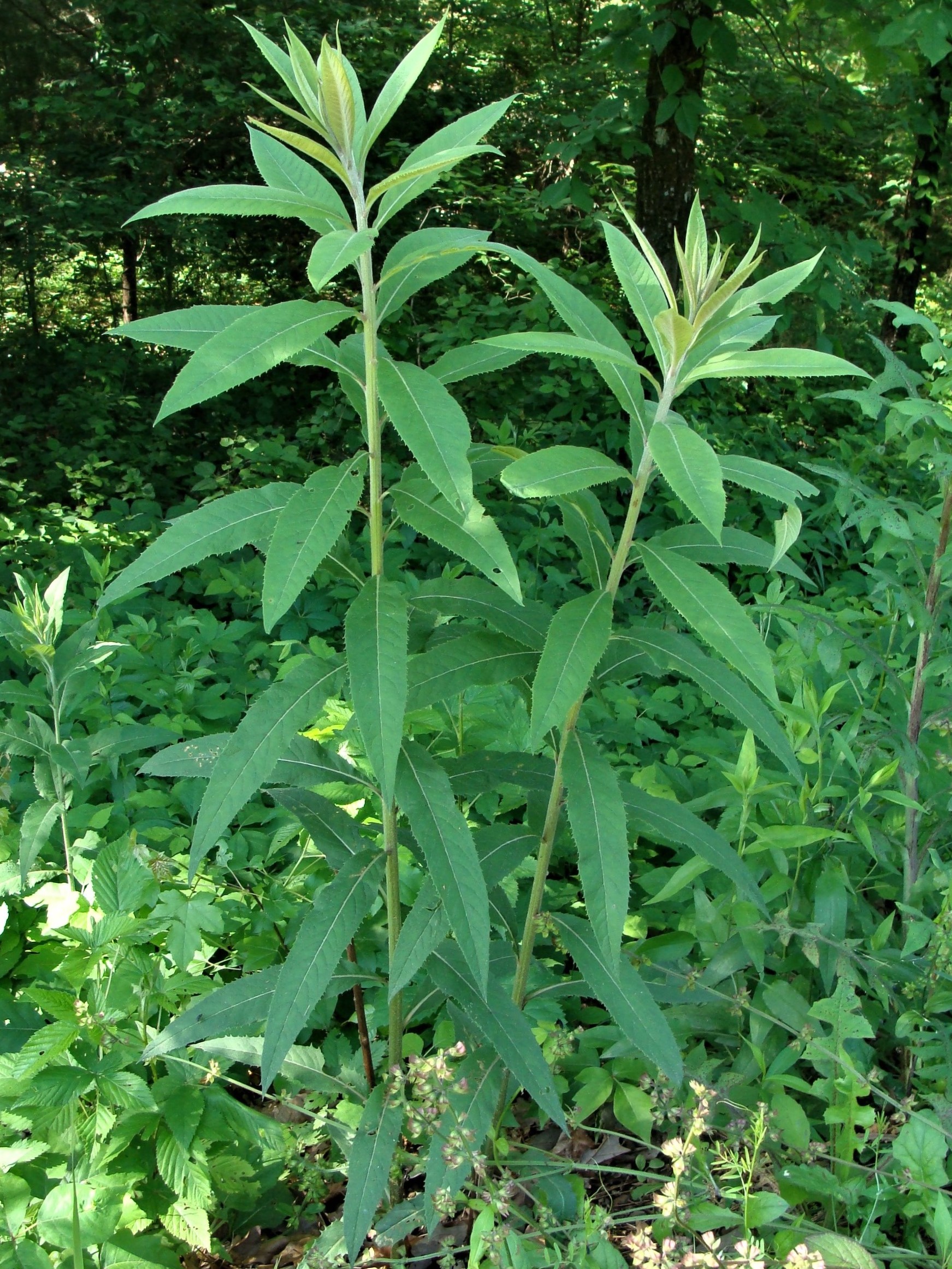Missouri ironweed (Vernonia missurica) of the Sunflower or Aster (Asteraceae) family has vivid purple to magenta composite flowerheads in midsummer. The primary area of occurrence extends from western Florida to eastern Texas, north and east to Indiana and southern Michigan. In Arkansas, the species occurs throughout most of the state, though apparently absent from portions of the Ozark Mountains. The genus name commemorates William Vernon, an English botanist who worked in Maryland in the late 1600s. The specific epithet means ‘of Missouri’, in reference to where the species was originally described. Preferred habitat consists of various moist to mesic loamy to sandy soils found in low lying areas of prairies, woodlands, and drainage ditches.
This sturdy herbaceous perennial has a root crown with a mass of whitish ropy roots. New stems sprout from the periphery of the crown as central old stems die and form a tough, hard rootstock. Rhizomes, to a foot long, may extend from this rootstock and terminate with an offset clonal plant.

Missouri ironweed is an erect herbaceous perennial with one or more tough, erect, round, ridged stems 3-5(-6) feet tall. Stems are unbranched except at the upper nodes, where lateral branching terminates in flowerheads (see below), producing a large, showy inflorescence. Stems and branches bear a dense coat of short, soft, white, tangled hairs, especially along ridges, that continue onto peduncles (ca 1 inch long) and pedicels (ca ½ inch long).


The alternate, mostly lanceolate-elliptic leaves are widest at the middle. Larger stem leaves measure about 6 inches long and 1½ inches wide. Apexes are acuminate (gradually tapering); sessile bases (without petioles) to subsessile bases (very short petioles) are cuneate (wedge shaped). Bases may have a light purplish shading. Leaf margins have weak serrations with tiny white tips; serrations decrease toward base and apex. Upper leaf surface is medium green with a glabrous (hairless), whitish midrib, especially along the lower portion. Lower leaf surface is light to whitish green. The upper leaf surface feels slightly rough (the hairs are short and stiff but not readily seen), while the lower surface feels downy from the tomentose pubescence.

Missouri ironweed’s inflorescence consist of flowerheads comprising up to 45 or more disk florets. Flowerheads are organized into small, flat-topped, cymose arrays terminating branches growing from the main stem and upper leaf axils. Flowering begins at the terminal clusters of the main stem and gradually spreads outward. A single stem may support 200 flowerheads. The overall inflorescence is flat-topped.
The heads’ urn-shaped involucres, ¼ inch long and wide, are composed of five to seven series of imbricated bracts, called phyllaries in the composite family. Phyllaries are tightly appressed their entire length, broadly ovate, and ciliate along the margins. They are dark green in the center, with lighter-colored margins that turn purplish when flowerheads are in bloom.
As heads start to flower, a thick broom-like cluster of hairs or bristles appears above the involucre. The “broom” constitutes the “pappus,”* a cluster of 12-20 hairs attached to the top of each ovary in the head. Purple to magenta tubular corollas soon push out of the encircling bristles, forming a showy, frilly flowerhead. Corollas have five sharply tipped recurving lobes, five stamens and a single pistil with an inferior ovary. The thin elongate anthers of the stamens form a tube around the style. As the style elongates through the anthers, it carries their pollen above the corolla, where it can be picked up by pollinating insects. Stamens soon wilt, after which the upper portion of style divides and coils backward to expose two elongate, now-receptive, stigmatic surfaces. Flowerheads are up to 1 inch across and ¼ inch high.


Shortly after florets pass anthesis, the corolla, stamens, and style drop off. The ovaries then dry to become flattened, elongate, ridged achenes (often referred to as cypselae in the sunflower family). Pappus fluffs up to form a circle of radiating hairs. As achenes dry, they are dispersed by breezes.
For a moist to wet natural area or native plant garden, Missouri ironweed provides good vertical structure and showy flowers that attract butterflies and other insects. It can do well in partial or full sun, as determined by its dependence on good soil moisture. It is not eaten by rabbits or deer. Once plants are established, control may be needed to restrict spread (dead heading and pulling clonal plants).
Missouri ironweed is one of seven ironweeds that occur in the state. Species with similar characteristics and that are also widespread in Arkansas are tall ironweed (Vernonia gigantea) and Baldwin’s ironweed (Vernonia baldwinii). Characteristics to distinguish Missouri ironweed, considering the somewhat variable leaf shape and pubescence of the three species, are 1) tomentose stems, branches, lower leaf surfaces and 2) appressed, pointed phyllaries with purplish margins, and 3) relatively large number of florets per flowerhead. Tall ironweed has blunt, appressed phyllaries, and Baldwin’s ironweed has appressed phyllaries with pointed recurved tips (involucres appearing bristly). Both have fewer florets per flowerhead on average than Missouri ironweed. Additionally, tall ironweed leaves are not tomentose on the undersides. Where ranges overlap, ironweeds may hybridize.
Article and photographs by ANPS member Sid Vogelpohl

